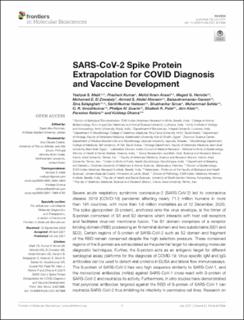| dc.contributor.author | Malik, Yashpal S. | |
| dc.contributor.author | Kumar, Prashnat | |
| dc.contributor.author | Ansari, Mohd Ikram | |
| dc.contributor.author | Hemida, Maged G. | |
| dc.contributor.author | El Zowalaty, Mohamed E. | |
| dc.contributor.author | Abdel-Moneim, Ahmed S. | |
| dc.contributor.author | Ganesh, Balasubramanian | |
| dc.contributor.author | Salajegheh, Sina | |
| dc.contributor.author | Natesan, Senthilkumar | |
| dc.contributor.author | Sircar, Shubhankar | |
| dc.contributor.author | Safdar, Muhammad | |
| dc.contributor.author | Vinodhkumar, O. R. | |
| dc.contributor.author | Duarte, Phelipe M. | |
| dc.contributor.author | Patel, Shailesh K. | |
| dc.contributor.author | Klein, Jörn | |
| dc.contributor.author | Rahimi, Parastoo | |
| dc.contributor.author | Dhama, Kuldeep | |
| dc.date.accessioned | 2021-09-07T10:30:38Z | |
| dc.date.available | 2021-09-07T10:30:38Z | |
| dc.date.created | 2021-02-18T08:35:02Z | |
| dc.date.issued | 2020 | |
| dc.identifier.citation | Malik, Y. S., Kumar, P., Ansari, M. I., Hemida, M. G., El Zowalaty, M. E., Abdel-Moneim, A. S., Ganesh, B., Salajegheh, S., Natesan, S., Sircar, S., Safdar, M., Vinodhkumar, O. R., Duarte, P. M., Patel, S. K., Klein, J., Rahimi, P., & Dhama, K. (2021). SARS-CoV-2 Spike Protein Extrapolation for COVID Diagnosis and Vaccine Development. Frontiers in Molecular Biosciences, 8, Artikkel 607886. | en_US |
| dc.identifier.issn | 2296-889X | |
| dc.identifier.uri | https://hdl.handle.net/11250/2773972 | |
| dc.description.abstract | Severe acute respiratory syndrome coronavirus-2 (SARS-CoV-2) led to coronavirus disease 2019 (COVID-19) pandemic affecting nearly 71.2 million humans in more than 191 countries, with more than 1.6 million mortalities as of 12 December, 2020. The spike glycoprotein (S-protein), anchored onto the virus envelope, is the trimer of S-protein comprised of S1 and S2 domains which interacts with host cell receptors and facilitates virus-cell membrane fusion. The S1 domain comprises of a receptor binding domain (RBD) possessing an N-terminal domain and two subdomains (SD1 and SD2). Certain regions of S-protein of SARS-CoV-2 such as S2 domain and fragment of the RBD remain conserved despite the high selection pressure. These conserved regions of the S-protein are extrapolated as the potential target for developing molecular diagnostic techniques. Further, the S-protein acts as an antigenic target for different serological assay platforms for the diagnosis of COVID-19. Virus-specific IgM and IgG antibodies can be used to detect viral proteins in ELISA and lateral flow immunoassays. The S-protein of SARS-CoV-2 has very high sequence similarity to SARS-CoV-1, and the monoclonal antibodies (mAbs) against SARS-CoV-1 cross-react with S-protein of SARS-CoV-2 and neutralize its activity. Furthermore, in vitro studies have demonstrated that polyclonal antibodies targeted against the RBD of S-protein of SARS-CoV-1 can neutralize SARS-CoV-2 thus inhibiting its infectivity in permissive cell lines. Research on coronaviral S-proteins paves the way for the development of vaccines that may prevent SARS-CoV-2 infection and alleviate the current global coronavirus pandemic. However, specific neutralizing mAbs against SARS-CoV-2 are in clinical development. Therefore, neutralizing antibodies targeting SARS-CoV-2 S-protein are promising specific antiviral therapeutics for pre-and post-exposure prophylaxis and treatment of SARS-CoV-2 infection. We hereby review the approaches taken by researchers across the world to use spike gene and S-glycoprotein for the development of effective diagnostics, vaccines and therapeutics against SARA-CoV-2 infection the COVID-19 pandemic. | en_US |
| dc.language.iso | eng | en_US |
| dc.rights | Navngivelse 4.0 Internasjonal | * |
| dc.rights.uri | http://creativecommons.org/licenses/by/4.0/deed.no | * |
| dc.title | Sars-Cov-2 Spike Protein Extrapolation for COVID Diagnosis and Vaccine Development | en_US |
| dc.type | Peer reviewed | en_US |
| dc.type | Journal article | en_US |
| dc.description.version | publishedVersion | en_US |
| dc.rights.holder | © 2021 Malik, Kumar, Ansari, Hemida, El Zowalaty, Abdel-Moneim, Ganesh, Salajegheh, Natesan, Sircar, Safdar, Vinodhkumar, Duarte, Patel, Klein, Rahimi and Dhama. | en_US |
| dc.source.volume | 8 | en_US |
| dc.source.journal | Frontiers in Molecular Biosciences | en_US |
| dc.identifier.doi | https://doi.org/10.3389/fmolb.2021.607886 | |
| dc.identifier.cristin | 1891134 | |
| dc.source.articlenumber | 607886 | en_US |
| cristin.ispublished | false | |
| cristin.fulltext | postprint | |
| cristin.qualitycode | 1 | |

